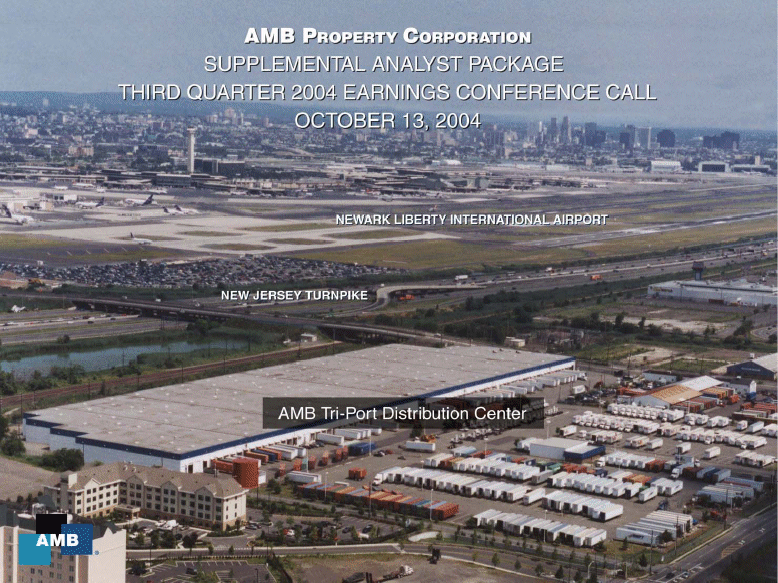
Exhibit 99.1


| TABLE OF CONTENTS i Cover: AMB Tri-Port Distribution Center, adjacent to the Ports of Newark and Elizabeth, New Jersey, and Newark Liberty International Airport (EWR), is a 490,830 square foot distribution facility acquired in September 2004. The property is fully leased to Federal Express Corporation. To reflect additional depreciation expense, management will restate AMB's previously issued financial statements for the years ended December 31, 2003, 2002 and 2001 filed on Form 10-K and for the quarters ended March 31, 2004 and June 30, 2004 filed on Form 10-Q. The restatement affects the company's depreciation expense, net income and earnings per share for the prior periods. The net impact of the restatement of depreciation expense on earnings per share results will reduce EPS by $0.02 from $1.43 to $1.41 for 2001; by $0.04 from $1.37 to $1.33 for 2002; by $0.06 from $1.47 to $1.41 for 2003. The net impact on each of the three months ended March 31 and June 30, 2004 will reduce EPS by $0.02 from $0.19 to $0.17 and by $0.02 from $0.22 to $0.20, respectively. This restatement of depreciation expense does not impact the company's previously reported funds from operations (FFO) per fully diluted share and unit as, in accordance with NAREIT's FFO definition, the company adds back real estate-related depreciation to calculate FFO. Please see the Company's earnings press release for more detail. |
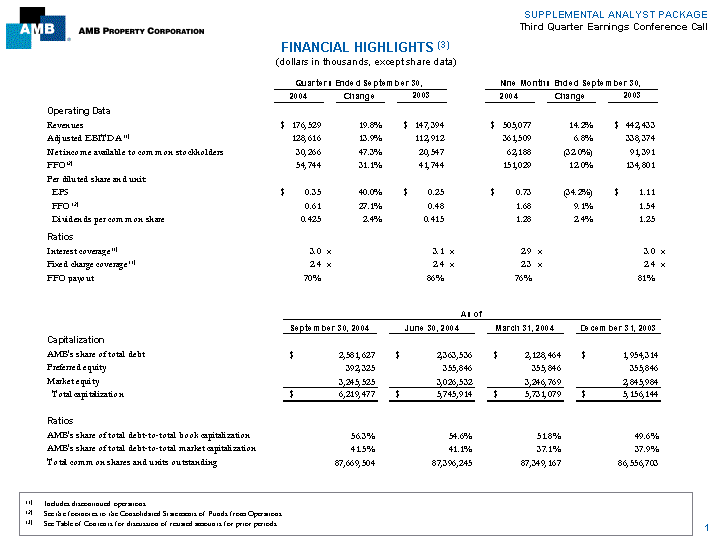
| SUPPLEMENTAL ANALYST PACKAGE Third Quarter Earnings Conference Call FINANCIAL HIGHLIGHTS (3) (dollars in thousands, except share data) (1) Includes discontinued operations. (2) See the footnotes to the Consolidated Statements of Funds from Operations. (3) See Table of Contents for discussion of restated amounts for prior periods. 1 |

| SUPPLEMENTAL ANALYST PACKAGE Third Quarter Earnings Conference Call CONSOLIDATED BALANCE SHEETS (1) (dollars in thousands) 2 (1) See Table of Contents for discussion of restated amounts for prior periods. |
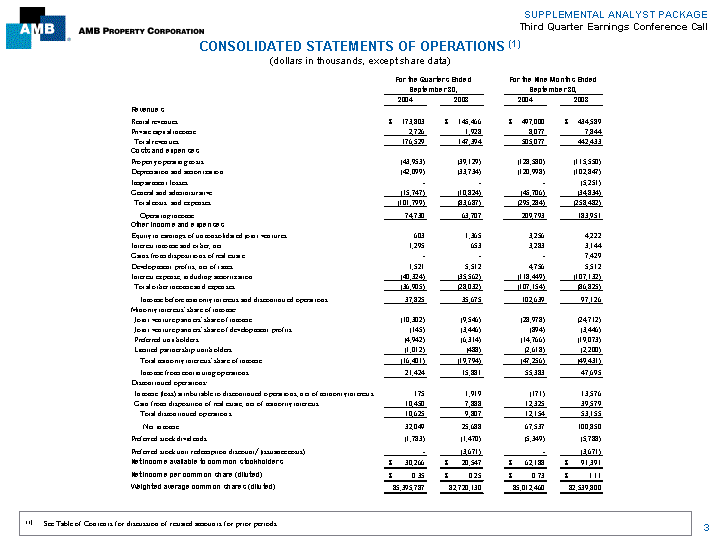
| SUPPLEMENTAL ANALYST PACKAGE Third Quarter Earnings Conference Call CONSOLIDATED STATEMENTS OF OPERATIONS (1) (dollars in thousands, except share data) 3 (1) See Table of Contents for discussion of restated amounts for prior periods. |
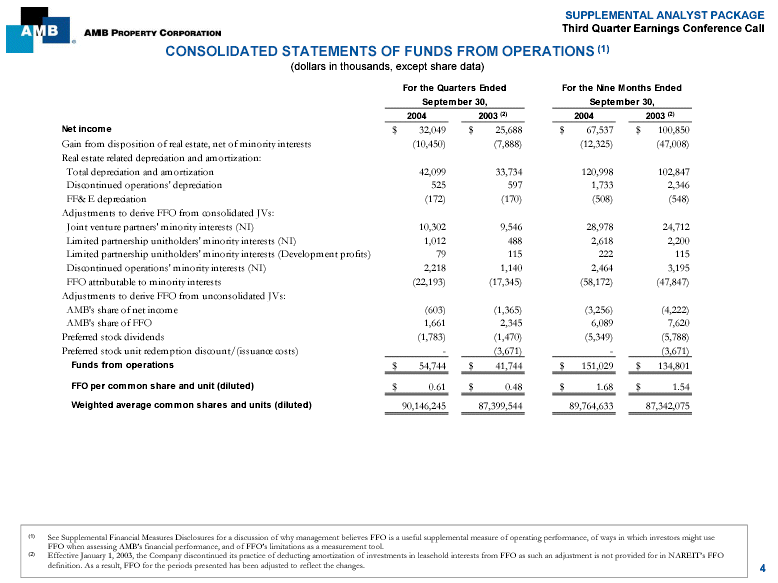
| CONSOLIDATED STATEMENTS OF FUNDS FROM OPERATIONS (1) (dollars in thousands, except share data) 4 (1) See Supplemental Financial Measures Disclosures for a discussion of why management believes FFO is a useful supplemental measure of operating performance, of ways in which investors might use FFO when assessing AMB's financial performance, and of FFO's limitations as a measurement tool. (2) Effective January 1, 2003, the Company discontinued its practice of deducting amortization of investments in leasehold interests from FFO as such an adjustment is not provided for in NAREIT's FFO definition. As a result, FFO for the periods presented has been adjusted to reflect the changes. |
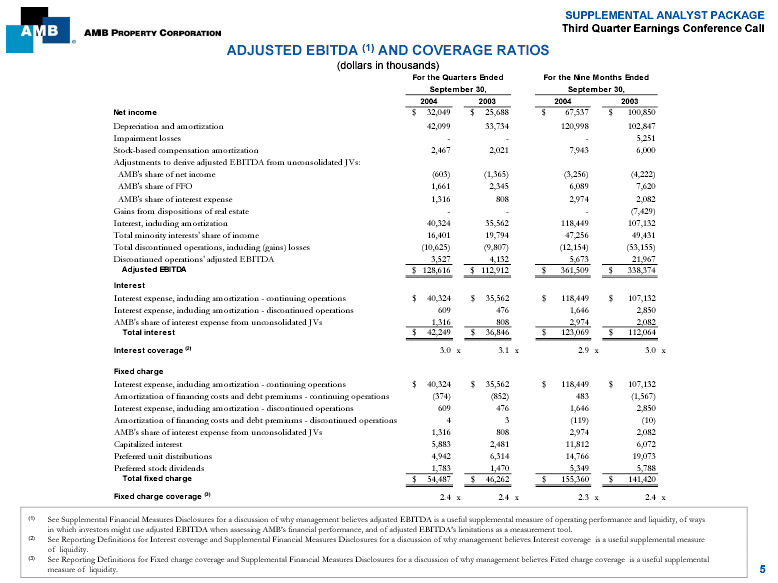
| ADJUSTED EBITDA (1) AND COVERAGE RATIOS (dollars in thousands) 5 (1) See Supplemental Financial Measures Disclosures for a discussion of why management believes adjusted EBITDA is a useful supplemental measure of operating performance and liquidity, of ways in which investors might use adjusted EBITDA when assessing AMB's financial performance, and of adjusted EBITDA's limitations as a measurement tool. (2) See Reporting Definitions for Interest coverage and Supplemental Financial Measures Disclosures for a discussion of why management believes Interest coverage is a useful supplemental measure of liquidity. (3) See Reporting Definitions for Fixed charge coverage and Supplemental Financial Measures Disclosures for a discussion of why management believes Fixed charge coverage is a useful supplemental measure of liquidity. |
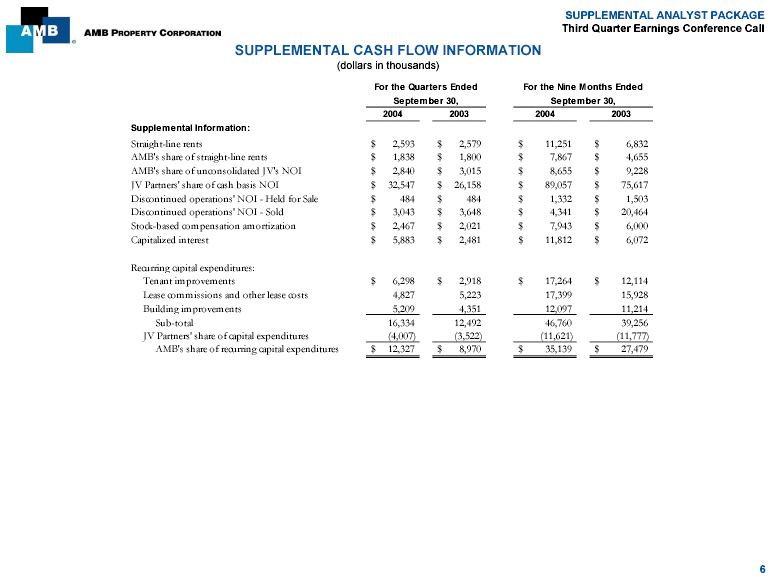
| SUPPLEMENTAL CASH FLOW INFORMATION (dollars in thousands) 6 |

| INDUSTRIAL OPERATING AND LEASING STATISTICS (dollars in thousands, except per square foot amounts) (1) Includes all consolidated industrial operating properties and excludes industrial development and renovation projects. Excludes retail and other properties' square feet of 474,368 with occupancy of 27.9% and annualized base rent of $3.1 million. (2) The same store pool excludes properties purchased and developments stabilized after December 31, 2002. See Reporting Definitions. (3) In addition to owned square feet as of September 30, 2004, the Company manages, through its subsidiary, AMB Capital Partners, 0.5 million additional square feet of industrial, retail and other properties. The Company also has investments in 8.0 million square feet of operating industrial properties through its investment in unconsolidated joint ventures. (4) Consists of second generation leases renewing or re-tenanting with current and prior lease terms greater than one year. 7 |
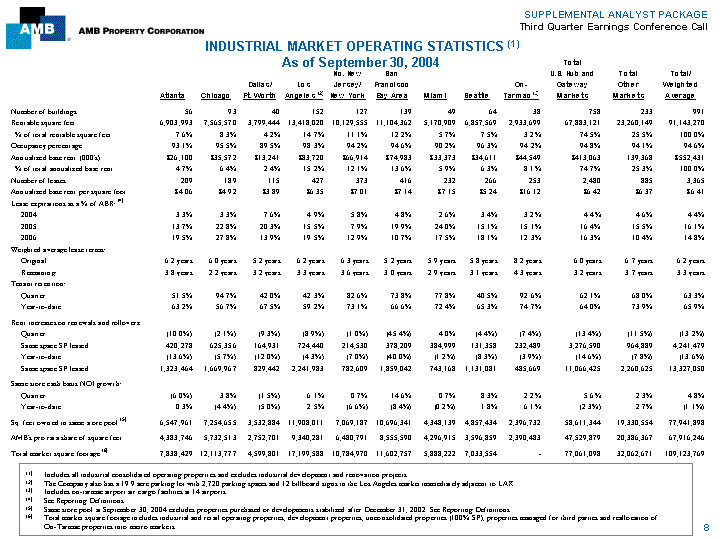
| INDUSTRIAL MARKET OPERATING STATISTICS (1) As of September 30, 2004 8 (1) Includes all industrial consolidated operating properties and excludes industrial development and renovation projects. (2) The Company also has a 19.9 acre parking lot with 2,720 parking spaces and 12 billboard signs in the Los Angeles market immediately adjacent to LAX. (3) Includes on-tarmac airport air cargo facilities at 14 airports. (4) See Reporting Definitions. (5) Same store pool at September 30, 2004 excludes properties purchased or developments stabilized after December 31, 2002. See Reporting Definitions. (6) Total market square footage includes industrial and retail operating properties, development properties, unconsolidated properties (100% SF), properties managed for third parties and reallocation of On-Tarmac properties into metro markets. |
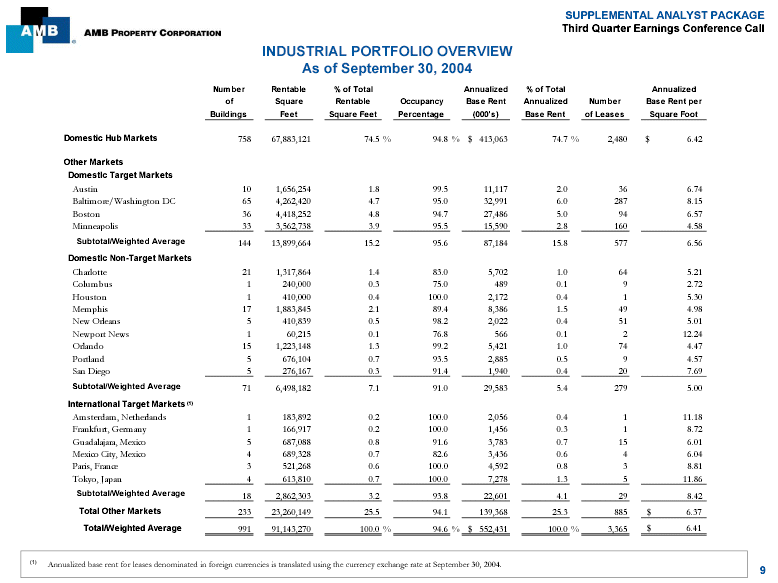
| INDUSTRIAL PORTFOLIO OVERVIEW As of September 30, 2004 9 (1) Annualized base rent for leases denominated in foreign currencies is translated using the currency exchange rate at September 30, 2004. |
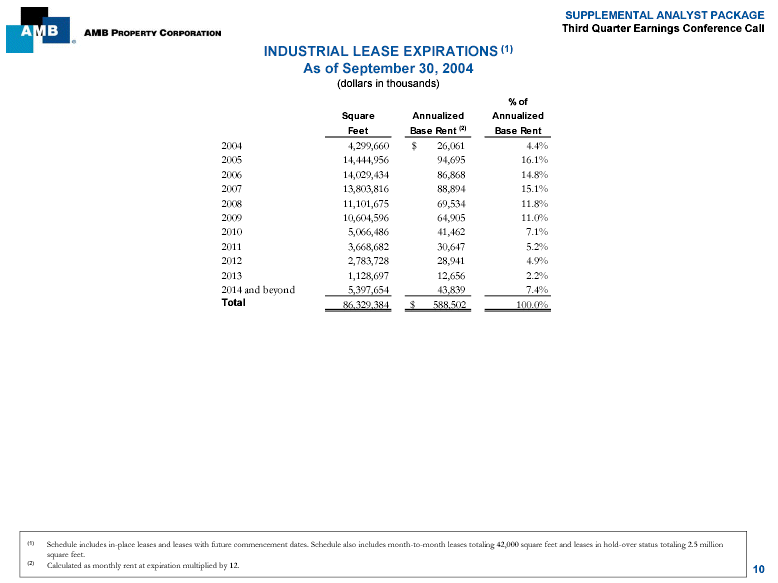
| INDUSTRIAL LEASE EXPIRATIONS (1) As of September 30, 2004 (dollars in thousands) (1) Schedule includes in-place leases and leases with future commencement dates. Schedule also includes month-to-month leases totaling 42,000 square feet and leases in hold-over status totaling 2.5 million square feet. (2) Calculated as monthly rent at expiration multiplied by 12. 10 |
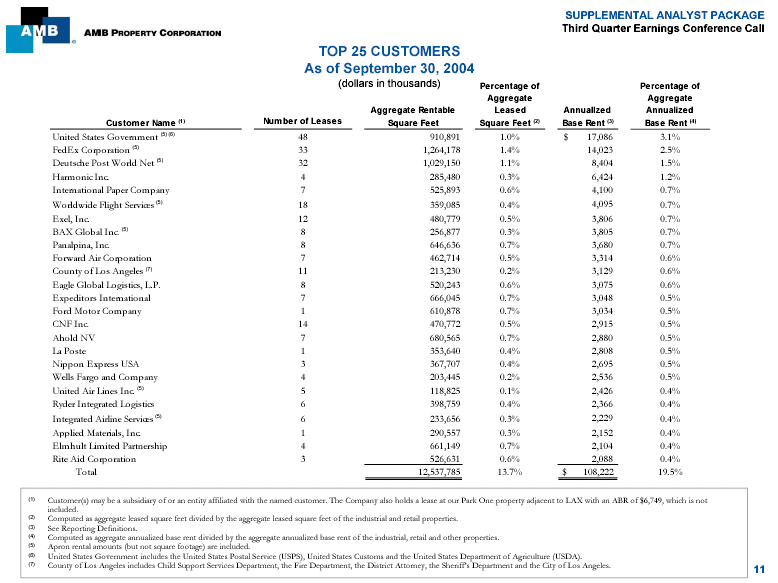
| TOP 25 CUSTOMERS As of September 30, 2004 (dollars in thousands) (1) Customer(s) may be a subsidiary of or an entity affiliated with the named customer. The Company also holds a lease at our Park One property adjacent to LAX with an ABR of $6,749, which is not included. (2) Computed as aggregate leased square feet divided by the aggregate leased square feet of the industrial and retail properties. (3) See Reporting Definitions. (4) Computed as aggregate annualized base rent divided by the aggregate annualized base rent of the industrial, retail and other properties. (5) Apron rental amounts (but not square footage) are included. (6) United States Government includes the United States Postal Service (USPS), United States Customs and the United States Department of Agriculture (USDA). (7) County of Los Angeles includes Child Support Services Department, the Fire Department, the District Attorney, the Sheriff's Department and the City of Los Angeles. 11 |
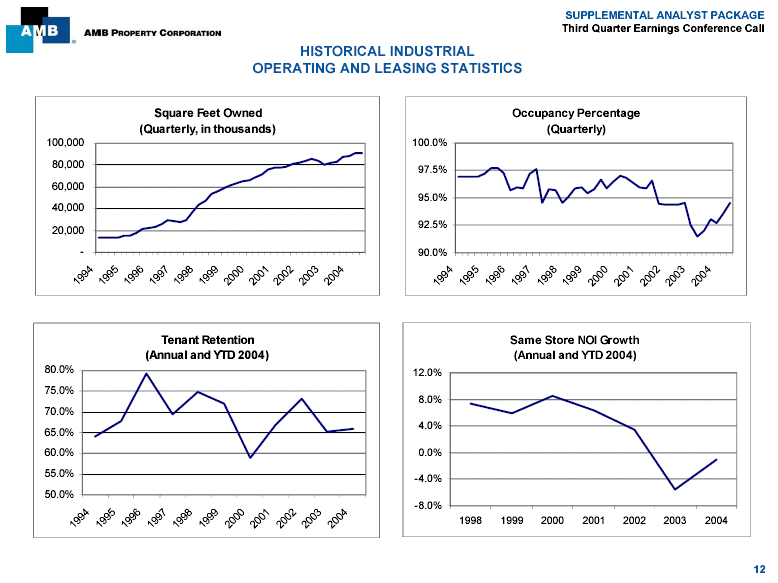
| HISTORICAL INDUSTRIAL OPERATING AND LEASING STATISTICS 12 |

| (1) Represents the total expected investment, including closing costs and estimated acquisition capital of $0.4 million. ACQUISITIONS For the Quarter ended September 30, 2004 (dollars in thousands) 13 |
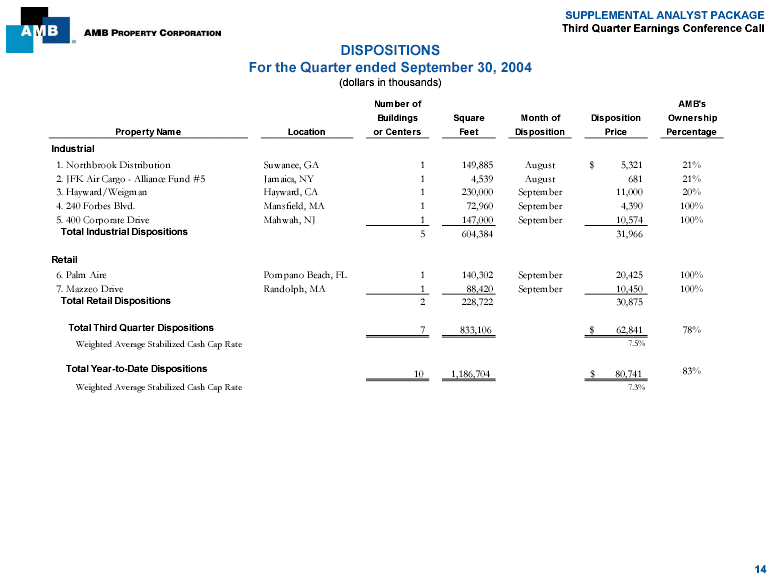
| DISPOSITIONS For the Quarter ended September 30, 2004 (dollars in thousands) 14 |
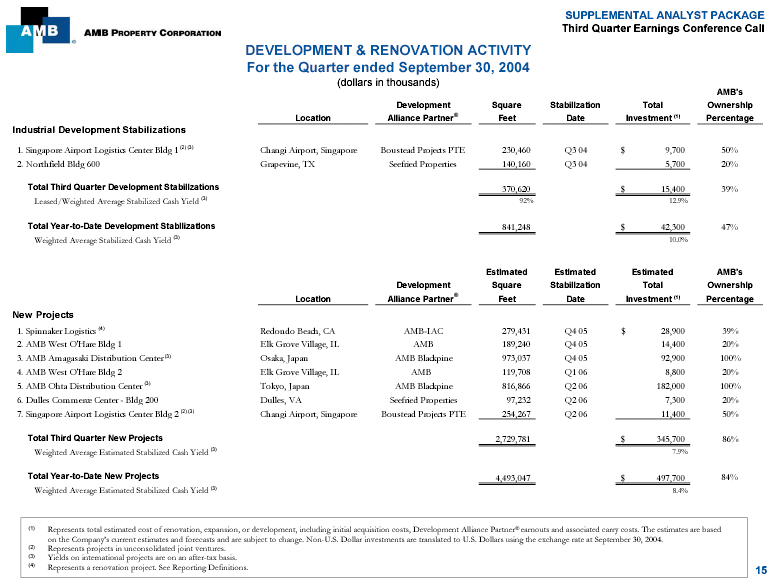
| DEVELOPMENT & RENOVATION ACTIVITY For the Quarter ended September 30, 2004 (dollars in thousands) 15 (1) Represents total estimated cost of renovation, expansion, or development, including initial acquisition costs, Development Alliance Partner(r) earnouts and associated carry costs. The estimates are based on the Company's current estimates and forecasts and are subject to change. Non-U.S. Dollar investments are translated to U.S. Dollars using the exchange rate at September 30, 2004. (2) Represents projects in unconsolidated joint ventures. (3) Yields on international projects are on an after-tax basis. (4) Represents a renovation project. See Reporting Definitions. |
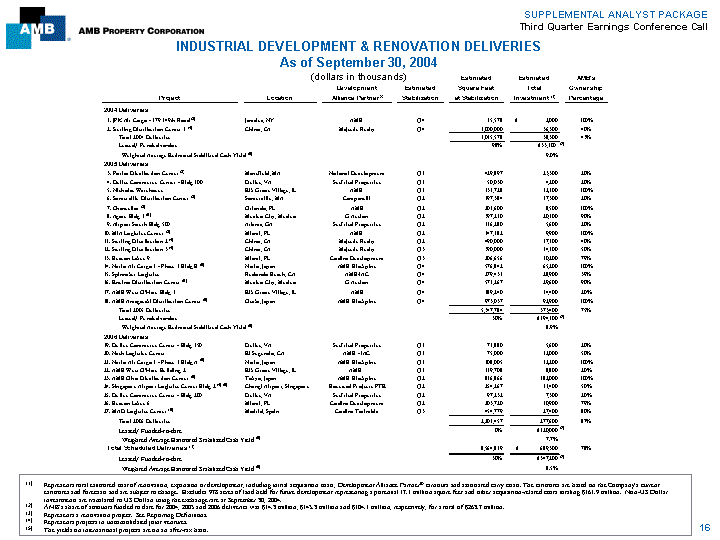
| INDUSTRIAL DEVELOPMENT & RENOVATION DELIVERIES As of September 30, 2004 (dollars in thousands) (1) Represents total estimated cost of renovation, expansion or development, including initial acquisition costs, Development Alliance Partner(r) earnouts and associated carry costs. The estimates are based on the Company's current estimates and forecasts and are subject to change. Excludes 978 acres of land held for future development representing a potential 17.1 million square feet and other acquisition-related costs totaling $161.9 million. Non-US Dollar investments are translated to US Dollars using the exchange rate at September 30, 2004. (2) AMB's share of amounts funded to date for 2004, 2005 and 2006 deliveries was $14.3 million, $145.3 million and $104.1 million, respectively, for a total of $263.7 million. (3) Represents a renovation project. See Reporting Definitions. (4) Represents projects in unconsolidated joint ventures. (5) The yields on international projects are on an after-tax basis. 16 |
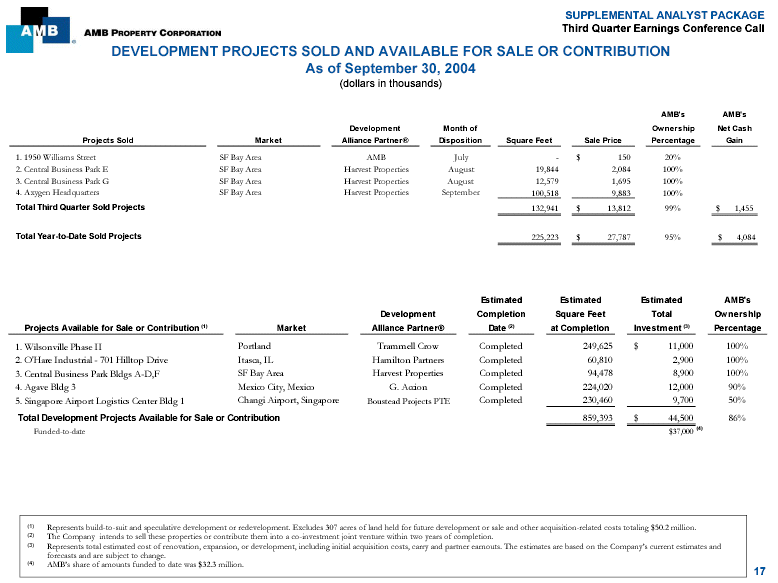
| (1) Represents build-to-suit and speculative development or redevelopment. Excludes 307 acres of land held for future development or sale and other acquisition-related costs totaling $50.2 million. (2) The Company intends to sell these properties or contribute them into a co-investment joint venture within two years of completion. (3) Represents total estimated cost of renovation, expansion, or development, including initial acquisition costs, carry and partner earnouts. The estimates are based on the Company's current estimates and forecasts and are subject to change. (4) AMB's share of amounts funded to date was $32.3 million. DEVELOPMENT PROJECTS SOLD AND AVAILABLE FOR SALE OR CONTRIBUTION As of September 30, 2004 (dollars in thousands) 17 |

| CAPITALIZATION SUMMARY As of September 30, 2004 (dollars in thousands, except share price) 18 (1) Represents three credit facilities with total capacity of approximately $768.0 million. Includes Euro and Yen based borrowings translated to US Dollars using the foreign exchange rates at September 30, 2004. (2) With certain exceptions, until November 10, 2005, the Company can require the purchaser to return these notes to the Company for cancellation for an obligation of equal dollar amount under a secured first mortgage loan. (3) The weighted average interest and maturity for the unconsolidated JV debt were 5.3% and 4.3 years, respectively. (4) Exchangeable under certain circumstances by the unitholder and redeemable at the option of the Company after a specified non-call period, generally five years from issuance. (5) The Series N preferred units are putable at the option of the holder beginning June 1, 2005 and until January 15, 2006 at a price equal to $50 per unit, plus all accrued and unpaid distributions. Beginning September 25, 2006 and until September 25, 2009, the Series N preferred units are redeemable by the Company at a price equal to $49.75 per unit, plus all accrued and unpaid distributions. |
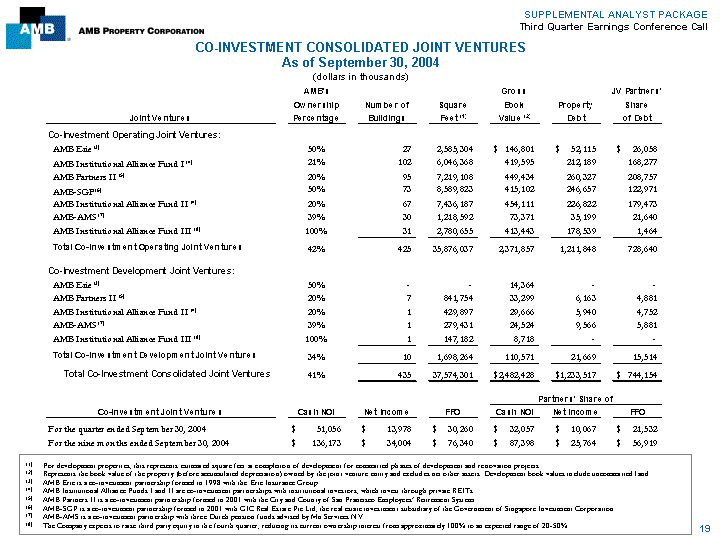
| CO-INVESTMENT CONSOLIDATED JOINT VENTURES As of September 30, 2004 (dollars in thousands) (1) For development properties, this represents estimated square feet at completion of development for committed phases of development and renovation projects. (2) Represents the book value of the property (before accumulated depreciation) owned by the joint venture entity and excludes net other assets. Development book values include uncommitted land. (3) AMB Erie is a co-investment partnership formed in 1998 with the Erie Insurance Group. (4) AMB Institutional Alliance Funds I and II are co-investment partnerships with institutional investors, which invest through private REITs. (5) AMB Partners II is a co-investment partnership formed in 2001 with the City and County of San Francisco Employees' Retirement System. (6) AMB-SGP is a co-investment partnership formed in 2001 with GIC Real Estate Pte Ltd, the real estate investment subsidiary of the Government of Singapore Investment Corporation. (7) AMB-AMS is a co-investment partnership with three Dutch pension funds advised by Mn Services NV. (8) The Company expects to raise third party equity in the fourth quarter, reducing its current ownership interest from approximately 100% to an expected range of 20-50%. 19 |
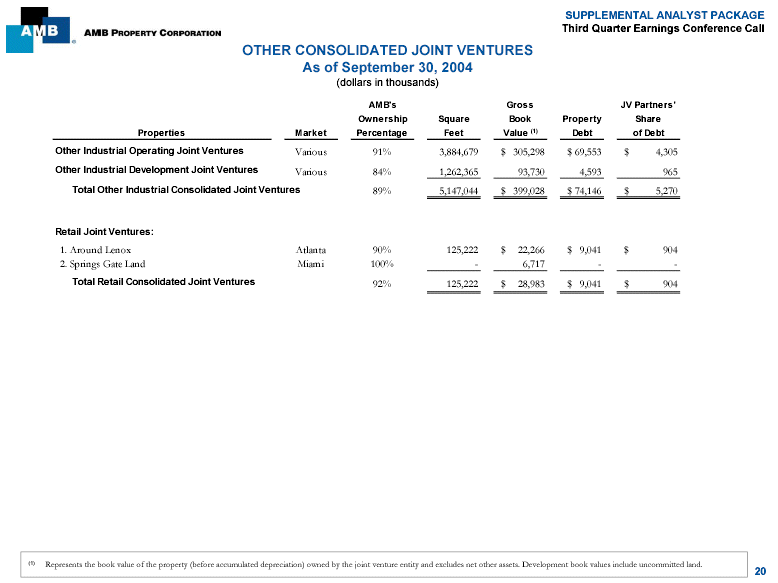
| OTHER CONSOLIDATED JOINT VENTURES As of September 30, 2004 (dollars in thousands) (1) Represents the book value of the property (before accumulated depreciation) owned by the joint venture entity and excludes net other assets. Development book values include uncommitted land. 20 |

| UNCONSOLIDATED JOINT VENTURES, MORTGAGE INVESTMENTS AND OTHER INVESTMENTS As of September 30, 2004 (dollars in thousands) (1) Square feet for development alliance joint ventures represents estimated square feet at completion of development project. (2) The Company also holds inter-company loans that it eliminates in consolidations. (3) AMB also has a 0.1% unconsolidated equity interest (with a 33% economic interest) in this property, and has an option to purchase the remaining equity interest beginning January 1, 2007 and expiring December 31, 2009. 21 |
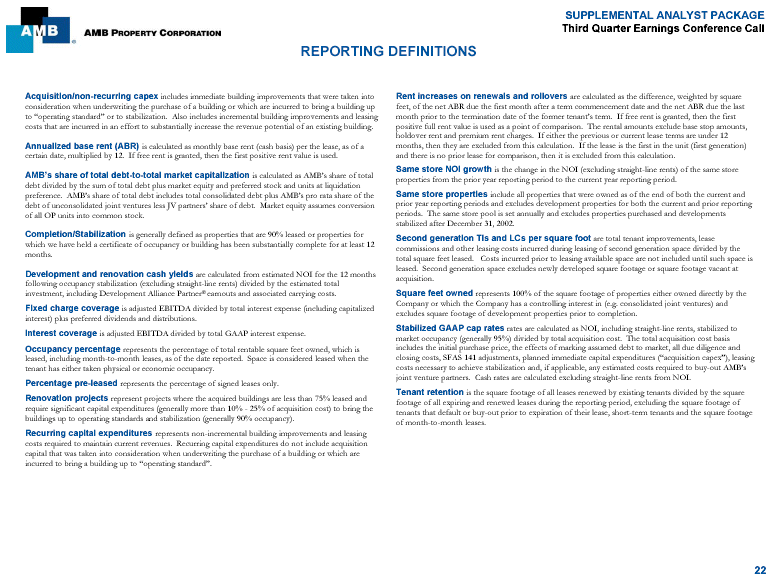
| REPORTING DEFINITIONS 22 Acquisition/non-recurring capex includes immediate building improvements that were taken into consideration when underwriting the purchase of a building or which are incurred to bring a building up to "operating standard" or to stabilization. Also includes incremental building improvements and leasing costs that are incurred in an effort to substantially increase the revenue potential of an existing building. Annualized base rent (ABR) is calculated as monthly base rent (cash basis) per the lease, as of a certain date, multiplied by 12. If free rent is granted, then the first positive rent value is used. AMB's share of total debt-to-total market capitalization is calculated as AMB's share of total debt divided by the sum of total debt plus market equity and preferred stock and units at liquidation preference. AMB's share of total debt includes total consolidated debt plus AMB's pro rata share of the debt of unconsolidated joint ventures less JV partners' share of debt. Market equity assumes conversion of all OP units into common stock. Completion/Stabilization is generally defined as properties that are 90% leased or properties for which we have held a certificate of occupancy or building has been substantially complete for at least 12 months. Development and renovation cash yields are calculated from estimated NOI for the 12 months following occupancy stabilization (excluding straight-line rents) divided by the estimated total investment, including Development Alliance Partner(r) earnouts and associated carrying costs. Fixed charge coverage is adjusted EBITDA divided by total interest expense (including capitalized interest) plus preferred dividends and distributions. Interest coverage is adjusted EBITDA divided by total GAAP interest expense. Occupancy percentage represents the percentage of total rentable square feet owned, which is leased, including month-to-month leases, as of the date reported. Space is considered leased when the tenant has either taken physical or economic occupancy. Percentage pre-leased represents the percentage of signed leases only. Renovation projects represent projects where the acquired buildings are less than 75% leased and require significant capital expenditures (generally more than 10% - 25% of acquisition cost) to bring the buildings up to operating standards and stabilization (generally 90% occupancy). Recurring capital expenditures represents non-incremental building improvements and leasing costs required to maintain current revenues. Recurring capital expenditures do not include acquisition capital that was taken into consideration when underwriting the purchase of a building or which are incurred to bring a building up to "operating standard". Rent increases on renewals and rollovers are calculated as the difference, weighted by square feet, of the net ABR due the first month after a term commencement date and the net ABR due the last month prior to the termination date of the former tenant's term. If free rent is granted, then the first positive full rent value is used as a point of comparison. The rental amounts exclude base stop amounts, holdover rent and premium rent charges. If either the previous or current lease terms are under 12 months, then they are excluded from this calculation. If the lease is the first in the unit (first generation) and there is no prior lease for comparison, then it is excluded from this calculation. Same store NOI growth is the change in the NOI (excluding straight-line rents) of the same store properties from the prior year reporting period to the current year reporting period. Same store properties include all properties that were owned as of the end of both the current and prior year reporting periods and excludes development properties for both the current and prior reporting periods. The same store pool is set annually and excludes properties purchased and developments stabilized after December 31, 2002. Second generation TIs and LCs per square foot are total tenant improvements, lease commissions and other leasing costs incurred during leasing of second generation space divided by the total square feet leased. Costs incurred prior to leasing available space are not included until such space is leased. Second generation space excludes newly developed square footage or square footage vacant at acquisition. Square feet owned represents 100% of the square footage of properties either owned directly by the Company or which the Company has a controlling interest in (e.g. consolidated joint ventures) and excludes square footage of development properties prior to completion. Stabilized GAAP cap rates rates are calculated as NOI, including straight-line rents, stabilized to market occupancy (generally 95%) divided by total acquisition cost. The total acquisition cost basis includes the initial purchase price, the effects of marking assumed debt to market, all due diligence and closing costs, SFAS 141 adjustments, planned immediate capital expenditures ("acquisition capex"), leasing costs necessary to achieve stabilization and, if applicable, any estimated costs required to buy-out AMB's joint venture partners. Cash rates are calculated excluding straight-line rents from NOI. Tenant retention is the square footage of all leases renewed by existing tenants divided by the square footage of all expiring and renewed leases during the reporting period, excluding the square footage of tenants that default or buy-out prior to expiration of their lease, short-term tenants and the square footage of month-to-month leases. |
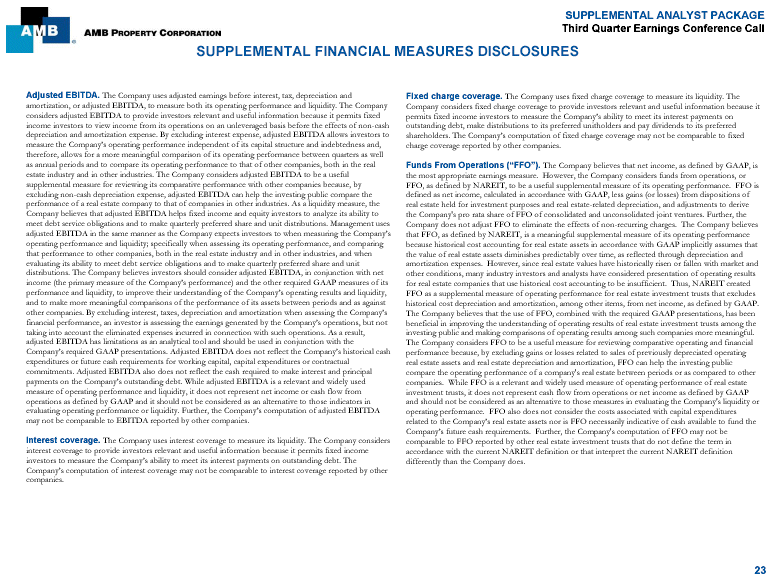
| SUPPLEMENTAL FINANCIAL MEASURES DISCLOSURES Adjusted EBITDA. The Company uses adjusted earnings before interest, tax, depreciation and amortization, or adjusted EBITDA, to measure both its operating performance and liquidity. The Company considers adjusted EBITDA to provide investors relevant and useful information because it permits fixed income investors to view income from its operations on an unleveraged basis before the effects of non-cash depreciation and amortization expense. By excluding interest expense, adjusted EBITDA allows investors to measure the Company's operating performance independent of its capital structure and indebtedness and, therefore, allows for a more meaningful comparison of its operating performance between quarters as well as annual periods and to compare its operating performance to that of other companies, both in the real estate industry and in other industries. The Company considers adjusted EBITDA to be a useful supplemental measure for reviewing its comparative performance with other companies because, by excluding non-cash depreciation expense, adjusted EBITDA can help the investing public compare the performance of a real estate company to that of companies in other industries. As a liquidity measure, the Company believes that adjusted EBITDA helps fixed income and equity investors to analyze its ability to meet debt service obligations and to make quarterly preferred share and unit distributions. Management uses adjusted EBITDA in the same manner as the Company expects investors to when measuring the Company's operating performance and liquidity; specifically when assessing its operating performance, and comparing that performance to other companies, both in the real estate industry and in other industries, and when evaluating its ability to meet debt service obligations and to make quarterly preferred share and unit distributions. The Company believes investors should consider adjusted EBITDA, in conjunction with net income (the primary measure of the Company's performance) and the other required GAAP measures of its performance and liquidity, to improve their understanding of the Company's operating results and liquidity, and to make more meaningful comparisons of the performance of its assets between periods and as against other companies. By excluding interest, taxes, depreciation and amortization when assessing the Company's financial performance, an investor is assessing the earnings generated by the Company's operations, but not taking into account the eliminated expenses incurred in connection with such operations. As a result, adjusted EBITDA has limitations as an analytical tool and should be used in conjunction with the Company's required GAAP presentations. Adjusted EBITDA does not reflect the Company's historical cash expenditures or future cash requirements for working capital, capital expenditures or contractual commitments. Adjusted EBITDA also does not reflect the cash required to make interest and principal payments on the Company's outstanding debt. While adjusted EBITDA is a relevant and widely used measure of operating performance and liquidity, it does not represent net income or cash flow from operations as defined by GAAP and it should not be considered as an alternative to those indicators in evaluating operating performance or liquidity. Further, the Company's computation of adjusted EBITDA may not be comparable to EBITDA reported by other companies. Interest coverage. The Company uses interest coverage to measure its liquidity. The Company considers interest coverage to provide investors relevant and useful information because it permits fixed income investors to measure the Company's ability to meet its interest payments on outstanding debt. The Company's computation of interest coverage may not be comparable to interest coverage reported by other companies. Fixed charge coverage. The Company uses fixed charge coverage to measure its liquidity. The Company considers fixed charge coverage to provide investors relevant and useful information because it permits fixed income investors to measure the Company's ability to meet its interest payments on outstanding debt, make distributions to its preferred unitholders and pay dividends to its preferred shareholders. The Company's computation of fixed charge coverage may not be comparable to fixed charge coverage reported by other companies. Funds From Operations ("FFO"). The Company believes that net income, as defined by GAAP, is the most appropriate earnings measure. However, the Company considers funds from operations, or FFO, as defined by NAREIT, to be a useful supplemental measure of its operating performance. FFO is defined as net income, calculated in accordance with GAAP, less gains (or losses) from dispositions of real estate held for investment purposes and real estate-related depreciation, and adjustments to derive the Company's pro rata share of FFO of consolidated and unconsolidated joint ventures. Further, the Company does not adjust FFO to eliminate the effects of non-recurring charges. The Company believes that FFO, as defined by NAREIT, is a meaningful supplemental measure of its operating performance because historical cost accounting for real estate assets in accordance with GAAP implicitly assumes that the value of real estate assets diminishes predictably over time, as reflected through depreciation and amortization expenses. However, since real estate values have historically risen or fallen with market and other conditions, many industry investors and analysts have considered presentation of operating results for real estate companies that use historical cost accounting to be insufficient. Thus, NAREIT created FFO as a supplemental measure of operating performance for real estate investment trusts that excludes historical cost depreciation and amortization, among other items, from net income, as defined by GAAP. The Company believes that the use of FFO, combined with the required GAAP presentations, has been beneficial in improving the understanding of operating results of real estate investment trusts among the investing public and making comparisons of operating results among such companies more meaningful. The Company considers FFO to be a useful measure for reviewing comparative operating and financial performance because, by excluding gains or losses related to sales of previously depreciated operating real estate assets and real estate depreciation and amortization, FFO can help the investing public compare the operating performance of a company's real estate between periods or as compared to other companies. While FFO is a relevant and widely used measure of operating performance of real estate investment trusts, it does not represent cash flow from operations or net income as defined by GAAP and should not be considered as an alternative to those measures in evaluating the Company's liquidity or operating performance. FFO also does not consider the costs associated with capital expenditures related to the Company's real estate assets nor is FFO necessarily indicative of cash available to fund the Company's future cash requirements. Further, the Company's computation of FFO may not be comparable to FFO reported by other real estate investment trusts that do not define the term in accordance with the current NAREIT definition or that interpret the current NAREIT definition differently than the Company does. 23 |
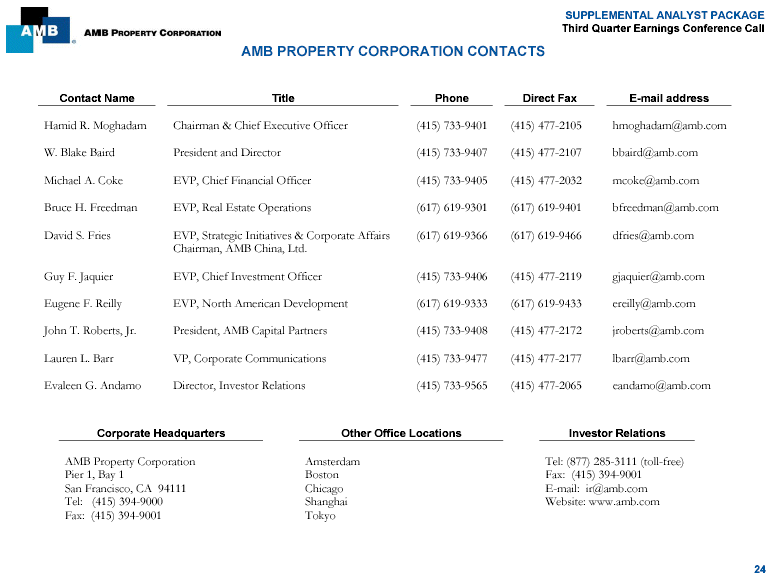
| AMB PROPERTY CORPORATION CONTACTS 24 |
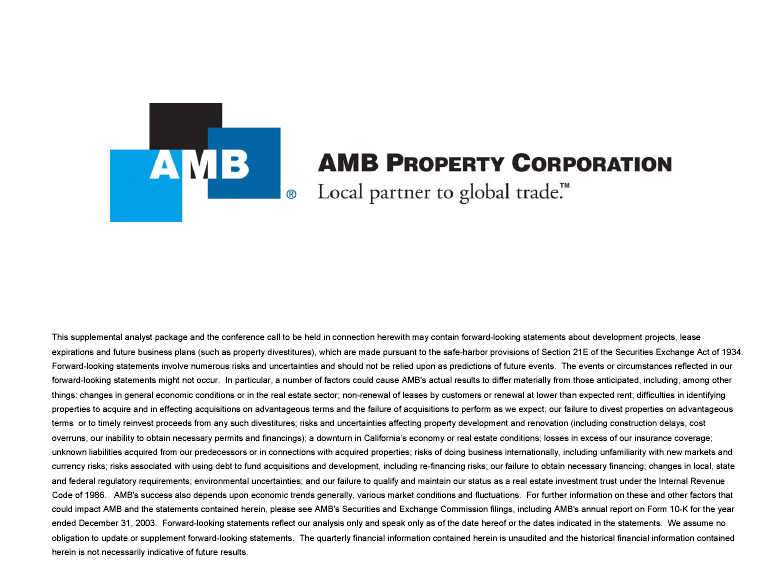
| This supplemental analyst package and the conference call to be held in connection herewith may contain forward-looking statements about development projects, lease expirations and future business plans (such as property divestitures), which are made pursuant to the safe-harbor provisions of Section 21E of the Securities Exchange Act of 1934. Forward-looking statements involve numerous risks and uncertainties and should not be relied upon as predictions of future events. The events or circumstances reflected in our forward-looking statements might not occur. In particular, a number of factors could cause AMB's actual results to differ materially from those anticipated, including, among other things: changes in general economic conditions or in the real estate sector; non-renewal of leases by customers or renewal at lower than expected rent; difficulties in identifying properties to acquire and in effecting acquisitions on advantageous terms and the failure of acquisitions to perform as we expect; our failure to divest properties on advantageous terms or to timely reinvest proceeds from any such divestitures; risks and uncertainties affecting property development and renovation (including construction delays, cost overruns, our inability to obtain necessary permits and financings); a downturn in California's economy or real estate conditions; losses in excess of our insurance coverage; unknown liabilities acquired from our predecessors or in connections with acquired properties; risks of doing business internationally, including unfamiliarity with new markets and currency risks; risks associated with using debt to fund acquisitions and development, including re-financing risks; our failure to obtain necessary financing; changes in local, state and federal regulatory requirements; environmental uncertainties; and our failure to qualify and maintain our status as a real estate investment trust under the Internal Revenue Code of 1986. AMB's success also depends upon economic trends generally, various market conditions and fluctuations. For further information on these and other factors that could impact AMB and the statements contained herein, please see AMB's Securities and Exchange Commission filings, including AMB's annual report on Form 10-K for the year ended December 31, 2003. Forward-looking statements reflect our analysis only and speak only as of the date hereof or the dates indicated in the statements. We assume no obligation to update or supplement forward-looking statements. The quarterly financial information contained herein is unaudited and the historical financial information contained herein is not necessarily indicative of future results. |